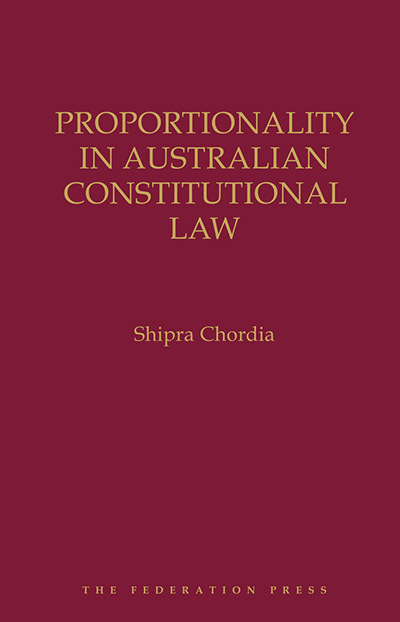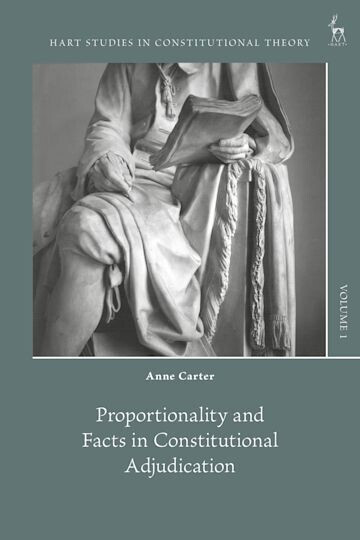- Winter 2022
- Proportionality in Australian Constitutional Law by Shipra Chordia and Proportionality and Facts in Constitutional Adjudication by Anne Carter
Proportionality in Australian Constitutional Law by Shipra Chordia and Proportionality and Facts in Constitutional Adjudication by Anne Carter

The High Court’s current approach to structured proportionality may be traced back to the decision of Kiefel J in Rowe v Electoral Commissioner (2010) 243 CLR 1 in which her Honour, in dissent and drawing heavily upon German and European law, applied structured proportionality in the context of the implied freedom of political communication. Despite earlier opposition to the translation of European proportionality jurisprudence into the Australian constitutional context (see Gleeson CJ in Roach v Electoral Commissioner (2007) 233 CLR 162 at [17]) her Honour’s vision gradually found favour with other members of the High Court, eventually commanding a majority in McCloy v New South Wales (2015) 257 CLR 178 (Kiefel, Bell and Keane JJ, together with French CJ). However, given the changing composition of the High Court the continuing role of structured proportionality remains unsettled. By January 2024, the doctrine’s chief proponent will have retired, and none of the majority in McCloy will be on the High Court. The next most senior judges, Gageler J and Gordon J, remain sceptical of the role of structured proportionality, while Edelman J, Steward J and Gleeson J have all concurred in judgments in which structured proportionality has been applied as an analytical tool, and the position of those who will replace Kiefel CJ and Keane J is of course unknown.
It is in that state of flux that Dr Shipra Chordia and Dr Anne Carter have provided two valuable contributions to the literature considering the role of structured proportionality in the Australian constitutional context.
Dr Chordia’s book begins with a survey of proportionality in western legal traditions, culminating in the development of structured proportionality in the German Constitutional Court and its adoption in a variety of jurisdictions, before also discussing various alternatives, in particular the formalism, ad hoc balancing and tiered scrutiny applied in the US Supreme Court. Dr Chordia then proceeds to discuss the application of proportionality in three different constitutional contexts: the characterisation of laws (in particular the so-called ‘purposive powers’); freedom of interstate trade and commerce; and the implied freedom of communication.
Dr Chordia provides a theoretical framework for the use of structured proportionality where a ‘balancing problem’ arises. A balancing problem exists where there is a conflict between two sets of rights or interests, each of which has the same prima facie normative force (constitutional), neither of which is absolute, and at least one of which is incapable of being defined in the abstract. This explains why, in Dr Chordia’s view, structured proportionality is not an appropriate analytical tool in solving problems of characterisation (where the conflict is between constitutional purpose and non-constitutional rights). Nor, according to Dr Chordia, is it an appropriate analytical tool for determining validity under the trade and commerce limb of s 92 (because following Cole v Whitfield’s determination that ‘absolutely free’ means ‘free from discriminatory burdens of a protectionist kind’ the s 92 freedom has a fixed definition in the abstract, and a definition in which the underlying balancing of interests is ‘baked in’). While the majority in Palmer v State of Western Australia [2021] HCA 3 expressed the view that structured proportionality was the appropriate form of analysis for both the trade and commerce and the intercourse limbs of s 92, Dr Chordia’s theoretical framework explains why structured proportionality may properly be applied to the intercourse limb (because interstate intercourse must be absolutely free from discriminatory burdens of any kind, the balance of competing interests is not ‘baked into’ the definition).
When it comes to determining whether or not a law impermissibly infringes upon the implied freedom of political communication, Dr Chordia endorses structured proportionality not merely as a useful tool, but as the preferable form of analysis. The analysis is not an uncritical acceptance of the approach adopted by the High Court in McCloy (and others). Dr Chordia accepts some of the criticisms levelled at structured proportionality, including by Gageler J and Gordon J that it can be too ‘algorithmic’, but proposes that structured proportionality should retain a degree of flexibility in its application to each stage of the analysis (the current Australian approach, particularly at the ‘necessity’ stage with its insistence that alternatives be ‘obvious and compelling’ is antithetical to such flexibility), and should be firmly conditioned by appropriate notions of judicial restraint (a subject discussed in more detail in Chapter 4) having regard to the constitutional role of parliament and the courts, and the capacity of parliaments (more so than courts) to evaluate whether alternative means that have a less restrictive effect on freedom might not achieve the legislative purpose as effectively).

Dr Carter’s contribution addresses a more practical question of how courts are to go about undertaking the intensely fact- dependent inquiries involved in assessing proportionality. As Dr Carter notes in the introduction, ‘in applying tests of proportionality, judges must necessarily proceed on the basis of certain factual claims or assumptions about the world, and these often concern complex and contested social, political or economic issues.’
In Australia there has been a long-standing recognition that there are different categories of facts that require different approaches to fact-finding. In particular, there has been a distinction drawn between ‘ordinary questions of fact’ being those facts that ‘arise between the parties because one asserts and the other denies that events have occurred bringing one of them within some criterion of liability or excuse set up by the law’ and so-called ‘constitutional facts’ or ‘legislative facts’ being those matters of fact upon which the constitutional validity of a law falls to be determined.
As Dr Carter explains, in a world of structured proportionality, that traditional dichotomy is incomplete, because the facts relevant to the various stages of the structured proportionality analysis will often exhibit different characteristics. Recognising those different characteristics has implications for identifying the types of evidentiary material available, the level of satisfaction required, and the limits of the court’s capacity to evaluate the evidence.
In particular, as Dr Carter emphasises in Chapter 7, that recognition of the different characteristics of the facts relevant at different stages of the inquiry has procedural implications for how the High Court (in particular) finds facts. The frustrations expressed by the High Court about the special case procedures in Mineralogy Pty Ltd v Western Australia [2021] HCA 30 at [51] to [61] and again by Gageler J in Hornsby Shire Council v Commonwealth of Australia [2022] HCAT rans 105 may in part be a result of insufficient attention by parties and their advisers to identifying the facts that need to be found and addressing how they are to be proved if they cannot be agreed.
Dr Carter’s work provides an invaluable framework within which to consider those questions in the context of constitutional litigation applying structured proportionality.

Reviewed by Dominic Villa SC
